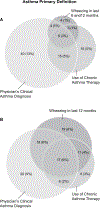Predictors of asthma following severe respiratory syncytial virus (RSV) bronchiolitis in early childhood
- PMID: 27152482
- PMCID: PMC6669901
- DOI: 10.1002/ppul.23461
Predictors of asthma following severe respiratory syncytial virus (RSV) bronchiolitis in early childhood
Abstract
Background: We sought to identify predictors of asthma development following severe early childhood RSV bronchiolitis. Different definitions of asthma were also compared.
Methods: This longitudinal, observational study (N = 343) followed patients (<2 years old) from a placebo-controlled trial (N = 979) of montelukast after RSV bronchiolitis to identify clinical, demographic, or biochemical predictors of asthma, atopic disorders, and chronic asthma therapy use at 6 years of age (Clinical Trials Registry Number: NCT01140048). Asthma (primary definition) was based on parental identification of wheeze at 6 AND 12 months before 6 years of age; definitions based on physician diagnosis as well as parental identification of wheeze at 6 OR 12 months (to consider seasonal effect) were also assessed. Post-hoc analyses evaluated agreement among asthma diagnosis criteria.
Results: Prevalence of asthma (primary definition by parental identification), asthma (physician diagnosis), atopic disorders, and chronic asthma therapy use (parental identification) was 6.1%, 22.4%, 36.2%, and 14.5%, respectively. Predictors for asthma (primary definition) included male gender, a relative with asthma, and RAST positive for dog dander; for physician diagnosis of asthma, high severity score for RSV bronchiolitis, high respiratory rate, and asthma diagnosis before enrollment. Predictors of atopic disorders included allergic rhinitis before enrollment, a relative with asthma, and the plasma biomarkers IL-5, IL-16, and IL-18. Predictors of chronic asthma therapy use included asthma diagnosis before enrollment and geographic region (Europe and Africa). Only 42% of patients with asthma (primary definition) also met the asthma definition by physician diagnosis and chronic asthma therapy use.
Conclusion: Among children with early RSV bronchiolitis, hereditary factors (i.e., having a relative with asthma) and RSV bronchiolitis severity were predictors of asthma and atopic disorders at 6 years of age. Of interest, there was poor agreement among the asthma definitions evaluated. Pediatr Pulmonol. 2016;51:1382-1392. © 2016 Wiley Periodicals, Inc.
Keywords: RSV bronchiolitis; asthma; asthma diagnosis; respiratory syncytial virus.
© 2016 Wiley Periodicals, Inc.
Conflict of interest statement
Conflicts of Interests
SL, HG, LN, AM, HP, BK, and TR are or were employees of Merck & Co., Inc., Kenilworth, NJ.
TH and ME report no conflicts of interest.
Figures




Comment in
-
Asthma after bronchiolitis: The outcome and risk factors depend on the age definition of bronchiolitis.Pediatr Pulmonol. 2016 Dec;51(12):1274-1275. doi: 10.1002/ppul.23542. Epub 2016 Jul 26. Pediatr Pulmonol. 2016. PMID: 27459241 No abstract available.
References
-
- Wright M, Piedimonte G. Respiratory syncytial virus prevention and therapy: past, present, and future. Pediatr Pulmonol 2011; 46: 324–347. - PubMed
-
- Stein RT, Sherrill D, Morgan WJ, Holberg CJ, Halonen M, Taussig LM, Wright AL, Martinez FD. Respiratory syncytial virus in early life and risk of wheeze and allergy by age 13 years. Lancet 1999; 354: 541–545. - PubMed
-
- Smyth RL, Openshaw PJ. Bronchiolitis. Lancet 2006; 368: 312–322. - PubMed
-
- Eriksson M, Bennet R, Nilsson A. Wheezing following lower respiratory tract infections with respiratory syncytial virus and influenza A in infancy. Pediatr Allergy Immunol 2000; 11: 193–197. - PubMed
Publication types
MeSH terms
Substances
Grants and funding
LinkOut - more resources
Full Text Sources
Other Literature Sources
Medical
Research Materials
Miscellaneous

